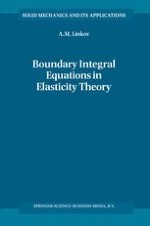2002 | Supplement | Chapter
Real Potentials of Elasticity Theory
Author : A. M. Linkov
Published in: Boundary Integral Equations in Elasticity Theory
Publisher: Springer Netherlands
Included in: Professional Book Archive
Activate our intelligent search to find suitable subject content or patents.
Select sections of text to find matching patents with Artificial Intelligence. powered by
Select sections of text to find additional relevant content using AI-assisted search. powered by
Consider the elastostatics equations for a region D, finite or infinite: 1.1% MathType!MTEF!2!1!+- % feaagCart1ev2aaatCvAUfeBSjuyZL2yd9gzLbvyNv2CaerbuLwBLn % hiov2DGi1BTfMBaeXatLxBI9gBaerbd9wDYLwzYbItLDharqqtubsr % 4rNCHbGeaGqiVu0Je9sqqrpepC0xbbL8F4rqqrFfpeea0xe9Lq-Jc9 % vqaqpepm0xbba9pwe9Q8fs0-yqaqpepae9pg0FirpepeKkFr0xfr-x % fr-xb9adbaqaaeGaciGaaiaabeqaamaabaabaaGcbaWaaSaaaeaacq % GHciITcqaHdpWCdaWgaaWcbaGaamyAaiaadQgaaeqaaaGcbaGaeyOa % IyRaamiEamaaBaaaleaacaWGQbaabeaaaaGccqGH9aqpcaaIWaGaai % ilaiaaywW7caWGPbGaeyypa0JaaGymaiaacYcacaaIYaGaaiilaiaa % iodaaaa!484E!]]</EquationSource><EquationSource Format="TEX"><![CDATA[$$\frac{{\partial {\sigma _{ij}}}}{{\partial {x_j}}} = 0,\quad i = 1,2,3$$, where σ ij are components of a stress tensor in the global co-ordinates which are assumed to be Cartesian. Here we use Einstein’s summation rule. The components of the stress tensor are connected to the components of the strain tensor by Hooke’s law: 1.2% MathType!MTEF!2!1!+- % feaagCart1ev2aaatCvAUfeBSjuyZL2yd9gzLbvyNv2CaerbuLwBLn % hiov2DGi1BTfMBaeXatLxBI9gBaerbd9wDYLwzYbItLDharqqtubsr % 4rNCHbGeaGqiVu0Je9sqqrpepC0xbbL8F4rqqrFfpeea0xe9Lq-Jc9 % vqaqpepm0xbba9pwe9Q8fs0-yqaqpepae9pg0FirpepeKkFr0xfr-x % fr-xb9adbaqaaeGaciGaaiaabeqaamaabaabaaGcbaGaeq4Wdm3aaS % baaSqaaiaadMgacaWGQbaabeaakiabg2da9iaadogadaWgaaWcbaGa % amyAaiaadQgacaWGRbGaamiBaaqabaGccqaH1oqzdaWgaaWcbaGaam % 4AaiaadYgaaeqaaOGaaiilaiaaywW7caWGPbGaaiilaiaadQgacqGH % 9aqpcaaIXaGaaiilaiaaikdacaGGSaGaaG4maaaa!4CCF!]]</EquationSource><EquationSource Format="TEX"><![CDATA[$${\sigma _{ij}} = {c_{ijkl}}{\varepsilon _{kl}},\quad i,j = 1,2,3$$, where c ijkl = c ijlk = c klij are elastic constants; ε kl are the components of the strain tensor: 1.3% MathType!MTEF!2!1!+- % feaagCart1ev2aaatCvAUfeBSjuyZL2yd9gzLbvyNv2CaerbuLwBLn % hiov2DGi1BTfMBaeXatLxBI9gBaerbd9wDYLwzYbItLDharqqtubsr % 4rNCHbGeaGqiVu0Je9sqqrpepC0xbbL8F4rqqrFfpeea0xe9Lq-Jc9 % vqaqpepm0xbba9pwe9Q8fs0-yqaqpepae9pg0FirpepeKkFr0xfr-x % fr-xb9adbaqaaeGaciGaaiaabeqaamaabaabaaGcbaGaeqyTdu2aaS % baaSqaaiaadUgacaWGSbaabeaakiabg2da9maalaaabaGaaGymaaqa % aiaaikdaaaWaaeWaaeaadaWcaaqaaiabgkGi2kaadwhadaWgaaWcba % Gaam4AaaqabaaakeaacqGHciITcaWG4bWaaSbaaSqaaiaadYgaaeqa % aaaakiabgUcaRmaalaaabaGaeyOaIyRaamyDamaaBaaaleaacaWGSb % aabeaaaOqaaiabgkGi2kaadIhadaWgaaWcbaGaam4AaaqabaaaaaGc % caGLOaGaayzkaaGaaiilaaaa!4D9A!]]</EquationSource><EquationSource Format="TEX"><![CDATA[$${\varepsilon _{kl}} = \frac{1}{2}\left( {\frac{{\partial {u_k}}}{{\partial {x_l}}} + \frac{{\partial {u_l}}}{{\partial {x_k}}}} \right),$$, u k are the components of the displacement vector u. Substitution of (1.3) into (1.2) and the result into (1.1) leads to the complete system of elasticity theory in terms of displacements: 1.4% MathType!MTEF!2!1!+- % feaagCart1ev2aaatCvAUfeBSjuyZL2yd9gzLbvyNv2CaerbuLwBLn % hiov2DGi1BTfMBaeXatLxBI9gBaerbd9wDYLwzYbItLDharqqtubsr % 4rNCHbGeaGqiVu0Je9sqqrpepC0xbbL8F4rqqrFfpeea0xe9Lq-Jc9 % vqaqpepm0xbba9pwe9Q8fs0-yqaqpepae9pg0FirpepeKkFr0xfr-x % fr-xb9adbaqaaeGaciGaaiaabeqaamaabaabaaGcbaGaam4yamaaBa % aaleaacaWGPbGaamOAaiaadUgacaWGSbaabeaakmaalaaabaGaeyOa % Iy7aaWbaaSqabeaacaaIYaaaaOGaamyDamaaBaaaleaacaWGRbaabe % aaaOqaaiabgkGi2kaadIhadaWgaaWcbaGaamOAaaqabaGccqGHciIT % caWG4bWaaSbaaSqaaiaadYgaaeqaaaaakiabg2da9iaaicdacaGGUa % aaaa!48DD!]]</EquationSource><EquationSource Format="TEX"><